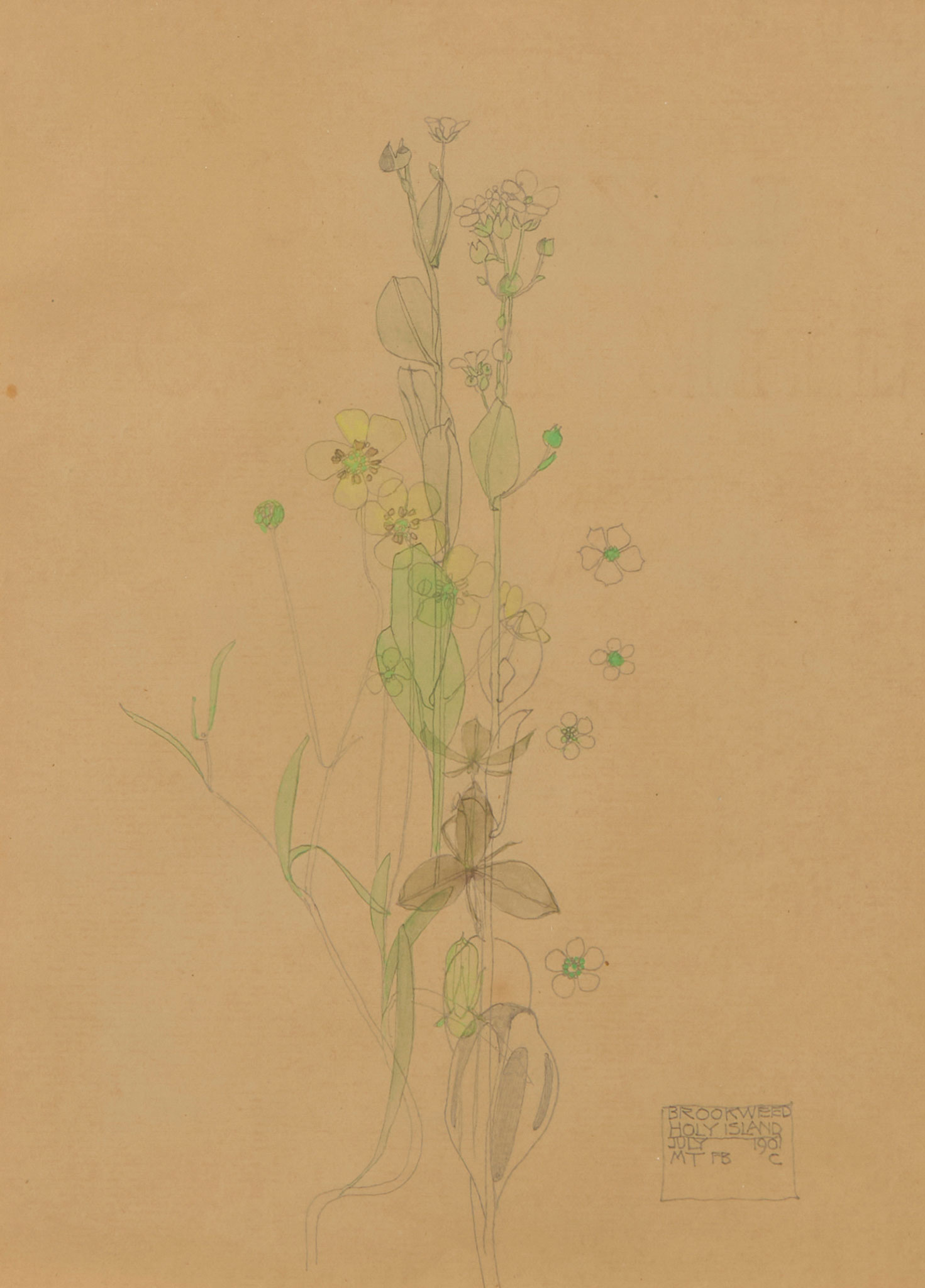CHARLES RENNIE MACKINTOSH (1868-1928)
'BROOKWEED', 1901
Estimate: £15,000 - £20,000
Auction: Day Two | Lots 253 to 490 | Thursday 17th April from 10am
Description
pencil and watercolour, signed and inscribed lower right BROOKWEED/ HOLY ISLAND/ JULY 1901/ MT FB C, framed
Dimensions
22cm x 17cm (frame size 44.5cm x 39.5cm)
Provenance
Provenance: William Marshall, Glasgow
Scottish Private Collection
Footnote
Exhibited: Edinburgh, London, Darmstadt, Zürich, Charles Rennie Mackintosh (1868-1928) Architecture, Design and Painting, 1968, Catalogue number 289, lent by William Marshall, Glasgow
1901 was a productive and exciting time for Mackintosh professionally, being the year that he was made a partner in the Glaswegian architectural practice where he worked. Seeking some brief respite from his busy roster of commissions, he and his wife Margaret took a holiday to Holy Island in the month of July, joined by the other members of ‘The Four’: Margaret’s sister Frances Macdonald and her husband Herbert McNair, as well as Margaret and Frances’s brother, Charles.
Given the trip was for such a short duration, sketches from this excursion are scarce. Nonetheless, the impact of this visit on both Mackintosh’s artistic and architectural practice was marked. For example, the surviving sketches show that he was deeply absorbed by Lindisfarne Castle. It has been noted that its sweeping, austere curves find echoes in his architectural language, for example in the Glasgow School of Art’s design which was completed in phases between 1896 and 1909.
Mackintosh had begun to develop his botanical studies in the 1890s, but the series of works from Holy Island are notable in that they crystallize the format for his botanical drawings thereafter. It is here, for example, that he begins to add his distinctive, almost Japanistic ‘cartouche’, featuring the initials of the companions present at the time of the work’s inception. In the past some have implied that the presence of ‘MM’ on such works suggest that Margaret did the colouring, but this does not fit with what is known of his attitude as an artist. Those close to him, notably Mary Sturrock - daughter of his friend and mentor Fra Newbery - are adamant that Mackintosh would not have let his artwork be added to in such a manner. Further support for this can be found in ‘Brookweed’ and other Holy Island watercolours, some of which feature more than two sets of initials. In ‘Brookweed’ the picture is signed M (for Margaret Macdonald), T (Tosh for Mackintosh himself), F (for Frances Macdonald), B (for Herbert (Bertie) McNair), and C (for Charles Macdonald, Margaret and Frances's brother), which appears to confirm the theory that the inscriptions were more of an aide memoire or dedication to those who were present when the pictures were made.
Botanic studies were central to Mackintosh’s artistic practise. Even when he was busy with his architectural business, they remain a mainstay. Mackintosh’s ideology had sprung from the tenets of the Arts and Crafts Movement, in tandem with European Art Nouveau, and it is crucial to understand that his design language, whether that be architecturally or artistically, ultimately found its basis in his belief that nature was the source of beauty.
His work across all media is characterised by a sinewy, linear approach to form, the distillation of the essential patterns and design of the natural world. This fascinating, alchemical process by which Mackintosh transforms the organic into design is arguably most tangible in his botanical studies, which perhaps explains their enduring appeal.
The drawings vary subtly over the course of time. From naturalistic depictions on Holy Island in 1901, to analytical, almost scientific studies in Sintra in 1908. Ultimately a more wholly decorative interest was developed post-1910, enhanced by the fact he is highly likely to have begun pressing his flower stems in order to more clearly expose the decorative formal possibilities. Finally, there was the explosion of botanical studies in Walberswick in 1914 (40 over a period of approximately 12 months), which marked a move from depictions purely of wildflowers to the inclusion of cultivated blooms.
Writing for The Studio in 1897, London critic Gleeson White remarked that the work of the ‘Spook School’, “is singularly free from vulgarity of idea, redundance of ornament, and misapplication of material…”. This sentiment holds across all aspects of Mackintosh’s work, but perhaps most particularly his botanical studies. This meeting of classicism and modernity, precision and invention, the spare and the decorative, goes some way to explain the timelessness of these pieces.

